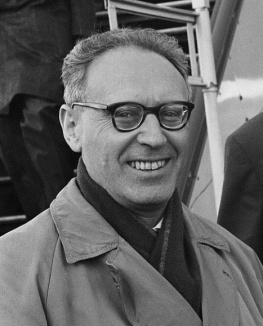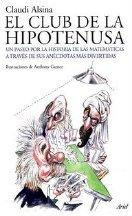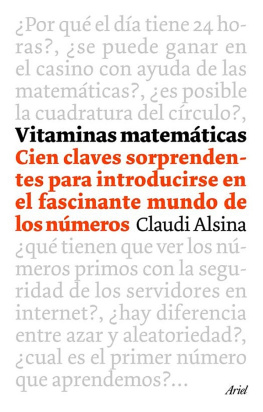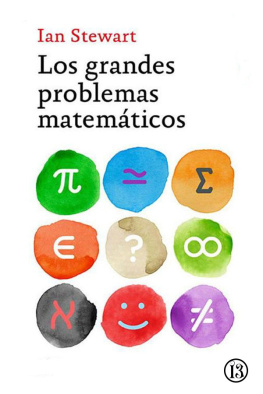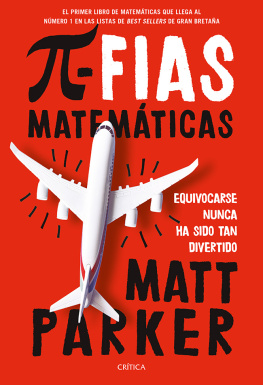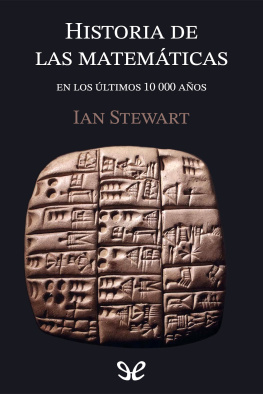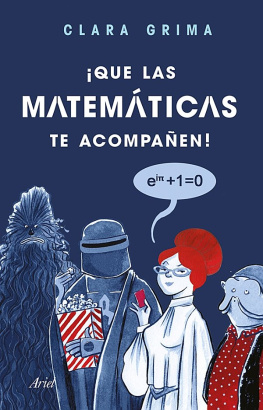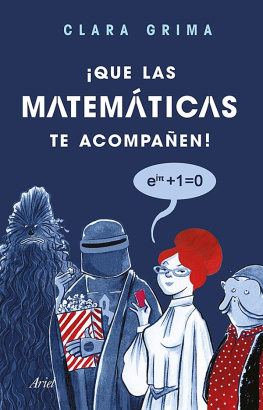Agradecimientos
Este libro no hubiera sido posible sin el apoyo continuo, inteligente y entusiasta de los bibliotecarios del Santa Fe Institute, la señora Margaret Alexander y el señor Timothy Taylor, y sin el compromiso y la mente y el lenguaje claros de Valerie Clement. Este libro ha contado con el apoyo y la habilidad editorial de Vickie Kearn, de la Universidad de Princeton, y el personal que trabaja con ella.
Quisiéramos extender nuestro agradecimiento a nuestro amigo Frank Wimberly, que colaboró con nosotros traduciendo al inglés las palabras de José Luis Massera y de sus compatriotas acerca de su experiencia carcelaria en el penal uruguayo llamado Libertad.
Agradecemos a Roger Frye, Claudia Henrion, Alexander Shen, Freeman Dyson, Ivor Grattan-Guinness, Chandler Davis, Allyn Jackson, Roy Lisker, Jenny Harrison, Moe Hirsh, Calvin C. Moore, Robert Osserman, Underwood Dudley, Nel Noddings, Kristin Umland, Cathy Fosnot, Peter Lax, Marry Ellen Rudin, Clarence Stephens, Nel Kroeger, Laura Cameron, Harry Lucas Jr., Richard J. Griego, Don Lemons, Jim Dudley, Peter Ross, Marjorie Senechal, Richard Kitchen, The Mathematical Intelligencer, la American Mathematical Society y a la Mathematical Association of America haber leído uno o varios capítulos del borrador, habernos dado permiso para citarlos, y haber corregido el texto y verificado la exactitud de los datos.
Por las conversaciones y cartas de apoyo, instructivas e inspiradoras, queremos darles las gracias a Sergio Albeverio, Michael Baron, Jonathan Borwein, Billy Brown, Mario Bunge, Laura Cameron, Menon Charbonneau, Paul Cohen, Brian Conrey, John Conway, Vageli Coutsias, Chandler Davis, Phil y Hadassah Davis, Martin Davis, Persi Diaconis, Jim y Mary Dudley, Underwood Dudley, Harold Edwards, Jim Ellison, Pedro Embid, Bernie Epstein, Dick Epstein, Paul Fawcett, Paul Fife, Cathy Fosnot, Marilyn Frankenstein, Claire y Roger Frye, Murray Gell-Man, Jekuthiel Ginsberg, Sylvia P. Glick, Brian Greer, Richard J. Griego, Tom y Rosa Hagstrom, Liong-Shin Hahn, Cliff Harris, Eva Hersh, Einar Hille, Moe Hirsch, Fritz John, Maria del Carmen Jorge Jorge, Tom, Gael y Nick Keyes, Allyn Jackson, Kirk Jensen, Richard Kitchen, Morris Kline, Steve Krantz, Serge Lang, Anneli y Peter Lax, Don Lemons, Ina Lindemann, Roy Lisker, Jens Lorentz, Wilhelm Magnus, Elena Marchisotto, Lisa Mersky, Cathleen Morawetz, Ed Nelson, Nel Noddings, Paul Noren, Bob Osserman, Cristina Pereyra, Ralph Philips, Klaus Peters, Arthur Powell, Gian-Carlo Rota, Peter Ross, Jill y Neal Singer, J.J. Shaffer, Santiago Simanca, Ernesto Sobrevilla-Soto, Stan Steinberg, Constantino Tsallis, Robert Thomas, Kristin Umland, Greve Unnever, Wilfredo Urbina, Cotten y Larry Wallen, Hao Wang y Frank Wimberly.
Cualquier error o inexactitud en los que hayamos podido caer son, por supuesto, responsabilidad exclusiva de los autores.
Bibliografía
Abelson, P. (1965). «Relation of group activity to creativity in science», Daedalus (verano de 1965), p. 607.
Abraham, R., y Ueda, Y. (eds). (2000). The chaos avant-garde: Memories of the early days of chaos theory. Singapur: World Scientific, pp. 81-90.
Abramowitz, I. (1946). The Great Prisoners. Nueva York: E.P. Dutton, p. 142.
Accinelli, Elvio, y Markarian, Roberto (1996). Recuerdos, en Integrando. Centro de Estudiantes de Ingeniería, disponible en http://www.cmat.edu.uy/ ~mordecki/massera/sobre/ accinelli-markarian. html.
Aczel, A.D. (2006). The artist and the mathematician. Nueva York: Avalon Publishing Group.
Adler, A. (1972). «Mathematics and creativity», New Yorker, 19 de febrero de 1972. Reimpreso en Timothy Ferris (ed). (1983). The world treasury of physics, astronomy and mathematics. Back Bag Books, p. 435.
Albers, D., y Alexanderson, G. (1991). «A conversation with Ivan Niven», College Mathematics Journal 22 (5), pp. 371-402.
Albers, D.J. (1990). More mathematical people: Contemporary conversations. Boston: Harcourt Brace Jovanovich.
Albers, Don (2007). «John Todd, — Numerical mathematics pioneer», College Mathematics Journal 38.
Albers, Donald J., yAlexanderson, G.L. (1985). Mathematical people: Profiles and interviews. Boston: Birkhäuser, p. 287.
Aleksandrov, P.S. (2000). «A few words on A.N. Kolmogorov», Russian Mathematical Surveys 39 (4), pp. 5-7, en Kolmogorov in perspective. Providence, R.I.: American Mathematical Society, p. 142.
Atiyah, M. (1984). Entrevista. Mathematical Intelligencer 6 (1), p. 17.
Barrow-Green, J. (1997). Poincaré and the three body problem. Providence, R.I.: American Mathematical Society, p. 162.
Baruk, Henri (1978). Patients are like us. Nueva York: William Morrow. [Hay trad. cast.: Baruk, Henri, Hombres como nosotros: memorias de un nervopsiquiatra. Barcelona, Grijalbo, 1977].
Beaulieu (1993). «A Parisian café and ten proto-Bourbaki meetings (1934-1935)», Mathematical Ingelligencer 15 (1), pp. 27-35.
Beaulieu, L. (1999). «Bourbaki’s art of memory», Osiris 2, serie 2 vol. 14, Conmemorative practices in science: Historical perspectives on the Politics of Collective Memory, pp. 219-251.
Bell, E.T. (1965). Men of Mathematics. Nueva York: Simon & Schuster. [Hay trad. cast.: Bell, Eric Temple, Los Grandes matemáticos: (desde Zenón a Poincaré): su vida y sus obras, trad. de Felipe Jiménez de Asúa, Buenos Aires: Losada (Barcelona: Sagrafic), 2009].
Birman, J., Haimo, D.T., Landau, S., Srinivasan, B., Pless, V., y Taylor, J.E. (1991). «In her own words», Notices of the American Mathematical Society, 38 (7), pp. 702-706.
Bloom, Benjamin S. (1985). Developing talent in Young people. Nueva York: Ballantine Books.
Blum, L. (2005). «AWM’s first twenty years: The president’s perspectives», en Case, B.A., y Legget, A.M. (eds). (2005), Complexities: Women in mathematics, Princeton, N.J.: Princeton University Press, pp. 80-97.
Boas, R. (1990). Entrevista, en D.J. Albers, G.L. Alexanderson y C. Reid (eds.) More mathematical people: Contemporary conversations. Boston: Birkhäuser, p. 25.
Bollobas, Béla (ed). (1986). Littlewood’s miscellany. Cambridge: Cambridge University Press.
Bourbaki, N. (1948). «Foundations of mathematics for the working mathematician», Journal of Symbolic Logic 14, pp. 1-14.
— (1950). «The architecture of mathematics», American Mathematical Monthly 57, pp. 221-232.
Brockman, John (ed). (2004). Curious minds: How a child becomes a scientist. Nueva York: Pantheon Books.
Bronowski, J. (1965). Science and Human Values. Nueva York: Harper and Row.
Brown-Walker, J. (2005). «A double dose of discrimination», en Case, B.A., y Legget, A.M. (eds). (2005), Complexities: Women in mathematics. Princeton, N.J.: Princeton University Press, p. 189.
Byers, W. (2007). How mathematicians think: Using ambiguity, contradiction and paradox to create mathematics. Princeton, N.J.: Princeton University Press.
Campbell, D.M. (1985). «Beauty and the beast: The strange case of André Bloch», Mathematical Intelligencer 7 (4), pp. 36-38.
Carraher, T.N., Carraher, D., y Schliemann, A.D. (1985). «Mathematics in the streets and in the schools», British Journal of Developmental Psychology 3, pp. 21-29.
Cartan, H., y Ferrand, J. (1988). «The case of André Bloch», Mathematical Intelligencer 10 (1), p. 241.
Cartan, H.-M. (1980). «Nicholas Bourbaki and contemporary mathematics», Mathematical Intelligencer 2 (4), pp. 175-187.
Cartier, P. (2001). «A mad day’s work: From Grothendieck to Connes and Konsevitch», Bulletin of the American Mathematical Society 38 (4), pp. 389-408.


